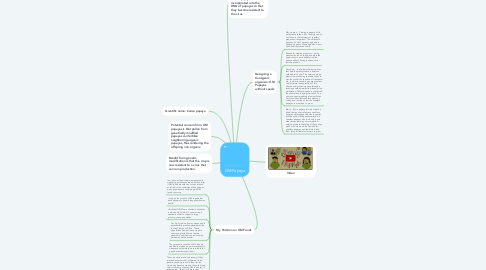GM Papaya
by Andrew Handrea

1. Scientific name: Carica papaya
2. GM technique: DNA from the ring spot virus that affects papayas is incorporated into the DNA of papayas so that they become resistant to the virus.
3. Benefit from genetic modification is that the crop is now resistant to a virus that can ruin production.
4. Potential concern from GM papayas is that pollen from genetically modified papayas can fertilize neighboring organic papayas, thus rendering the offspring non-organic.
5. My Position on GM Foods
5.1. I am more inclined toward not genetically modifying just because we do not know yet if GM foods are safe due to their relative novelty. But I do understand their value as many populations need high-yield GM foods to survive.
5.2. I support the growth of GM foods after enough years to know if they affect human health.
5.3. I think that GMO's are needed in situations in which a high yield of a certain crop is needed in order to support a large, growing, young population.
5.4. Yes, high yield crops may be needed in exponentially growing populations like those of India and China. These populations demand many crops to survive so plants like rice that are genetically modified to produce high yields may be the answer.
5.5. They present a social benefit if they are needed to make a crop more resistant to diseases and therefore more reliable for populations that need them.
5.6. These products are only necessary if they are needed for survival, otherwise I think people should try to avoid them for the time being because we don't know the long term implication of eating GM foods yet; in other words, I think if you are in the position to buy organic products over GM products you should but if you need to eat GM foods to survive you shouldn't avoid them.
6. Designing a transgenic organism: GM Papayas without seeds
6.1. Why create it... Clearing a papaya of its pesky seeds takes a lot of energy, so why not follow in the footsteps of seedless grapes and tangerines? This will benefit people who don't have enough time to de-seed papayas, like people who want a quick, healthy snack at work.
6.2. Reason for creating organism... giving people who live on the go and work the opportunity to eat a healthy fruit like papaya without having to spend time removing seeds.
6.3. Procedure... In all plants there are genes that help the plant produce a hormone called abscisic acid. This hormone stops plants from producing seeds during cold months so that the seeds don't freeze and die. In order to render a papaya seedless, I will promote the expression of this abscisic acid producing gene through a technique called permissive histone lysine methylation. When this gene is expressed, the plant will no longer grow seeds. The new, non-seed-producing plants will then be cloned like other seedless plants by cutting and rooting so that the seedless papayas can continue to grow.
6.4. Ethics... Some papaya farmers might be afraid that an over-reliance on seedless papayas will endanger the whole species as there will be little genetic variation in seedless papayas due to cloning. Some other issues that may occur are public suspicion toward the safety of these crops which will drive down the demand for seedless papayas and therefore make them less profitable for farmers to grow.
7. Video


